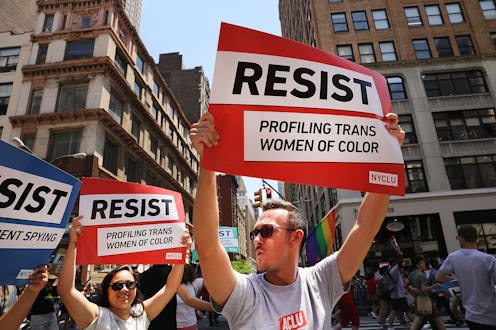News
More LGBTQ Americans Have Been Killed In 2017 Than All Of Last Year — REPORT

As of this month, 33 LGBTQ people have been killed in homicides related to hate violence in 2017, according to the National Coalition of Anti-Violence Programs. By comparison, there were 28 similar homicides in all of 2016 — though this number does not include the 49 people who were killed last summer during the Pulse nightclub in Orlando. This means that, excluding the Pulse nightclub shooting, more LGBTQ people have been killed in 2017 than in all of 2016 in hate-violence-related homicides.
These homicides have been occurring at an average rate of one every six days, compared to one every 13 days last year, according to BuzzFeed News. At least 16 transgender women of color have been killed in 2017 — a number that already surpasses the 15 reported deaths of transgender women in 2016 — as well as at least 12 cisgender gay men.
Beverly Tillery, the executive director at the New York City Anti-Violence Project, told BuzzFeed News that there are a combination of factors that could explain the higher number of reported homicides; a potential increase in anti-LGBTQ violence is one of them, but so is an increased focus on LGBTQ rights in the public sphere.
"I think whether it’s an increase in reporting, an increase in violence, or some combination thereof, it should be a wake-up call for us across our communities that hate violence is not going away, it’s certainly not decreasing, and it’s symptomatic of larger and deeper problems in our society that we still haven’t addressed," Tillery, whose agency worked with the NCAVP to compile the violence report, said.
The NCAVP's report gives a homicide the "hate violence" categorization if it appears that the perpetrator targeted the victim on the basis of gender identity or sexual orientation. This categorization does not, however, reflect whether or not law enforcement classified a homicide as a hate crime. But for Kathy Flores, an an LGBTQ anti-violence activist who knew and worked with a gay man — Andrew Nesbitt — who was killed this year, the NCAVP's count is valuable because it goes beyond legal definitions of hate violence to affirm anecdotal accounts.
"I think the distinction is different for advocates than it might be by the legal definition," Flores told BuzzFeed News, citing as an example a Milwaukee bartender who was killed after exiting a gay bar. "The intent may have been robbery but the victimization could have been related to the fact that he was gay and seen coming out of an LGBTQ establishment. So I think the targeting definitely does have hate and homophobia bias."
Before this latest NCAVP report was released to the website, 2016 was recorded as the deadliest year for LGBTQ people. In its 2016 report, the NCAVP found a 17 percent increase from 2015 in hate-violence-related homicides of LGBTQ people, and that number has only gone up in 2017.
Upon the release of its 2016 report, Shelby Chestnut, director of community organizing and public advocacy at Tillery's agency, told USA Today that "with increased visibility comes increased vulnerability" for LGBTQ individuals.
"We're not sending clear messages that LGBTQ lives are valued," Chestnut told USA Today at the time. Chestnut also added the following, and the sentiment still rings frighteningly true following the NCAVP's latest count:
People are dying as a result of anti-LGBT violence almost daily in this country, and it is everyone's problem. People need to understand that it's happening in their communities whether they're wealthy communities, poor communities, white communities, communities of color, immigrant communities. ... Now, more than ever, people need to stand up and defend the rights of LGBT people.